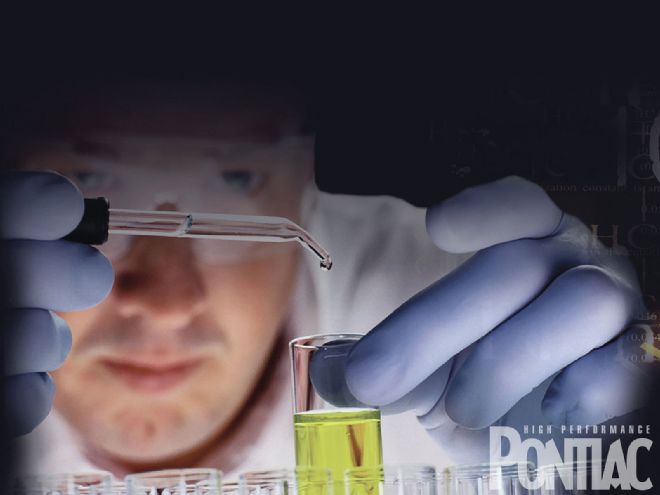
As Pontiac hobbyists we often state that, “We have gasoline running through our veins.” To many of us, life without the chemical-to-mechanical energy conversion that occurs inside the combustion chamber would seem almost unbearable. Even those passionate about the subject still know very little about the fuel that is a major focus of our interest. We know there are varied grades of gasoline, the stuff sold today is different from back in the glory days, and at the track you use race gas—and that’s about it. If that is the case with you, then this story will be an eye-opener.
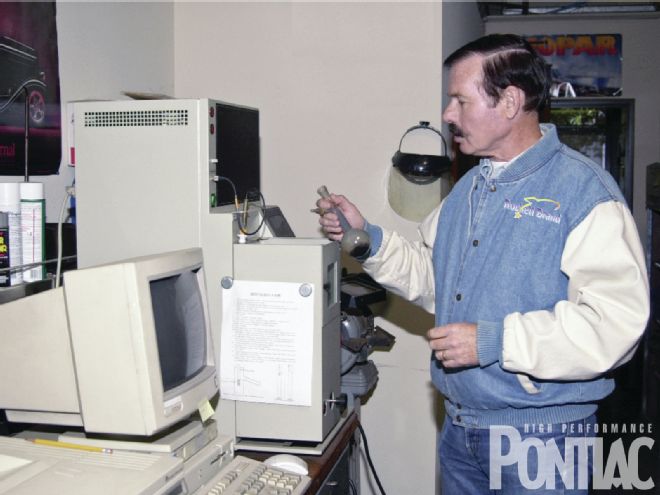 Tim Wusz of Rockett made a career out of supplying racing fuels and understands the needs of different engines.
Tim Wusz of Rockett made a career out of supplying racing fuels and understands the needs of different engines.
It is important to state early on in this primer that as the author, I, too was in the same situation as you when it came to a knowledge of gasoline. A few years back, I had the wonderful opportunity to spend an entire day at the research laboratory of a major oil company with the head engineer and chemist to entertain my questions. I learned more about fuel in that day than I had collectively over the course of my lifetime. Even after that experience I am still no expert, especially when it comes to the interaction of today’s fuel in a traditional Pontiac engine. It seems that modern gasoline has become the whipping boy for many things wrong under the hood of an older Pontiac. Is this fact or fiction? We need to find out.
This article is the result of another primer in this issue of HPP, where we take a ’73 SD-455 and run it on a dyno with four different fuels—some that are not even available to the public yet. At HPP, we know that if we have questions about how a Pontiac engine performs on modern fuel, you, as readers, have the same queries.
As we moved forward collecting the empirical data on the Pontiac engine with the varied fuel compositions, it quickly became apparent that this experiment was so cutting edge, it would leave many questions unanswered if we did not back it up with a proper explanation. Wanting to provide our readers with a comprehensive analysis of fuel led us to include this overview of gasoline, a one-two punch of the theoretical and empirical that is required to be successful in extracting the most horsepower from a Pontiac engine.
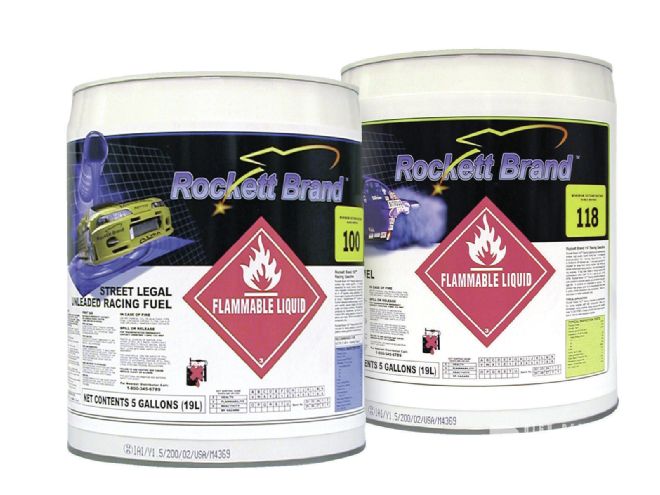 A true race gasoline is modified for best performance, but usually sacrifices other factors, such as cold weather starting and warm up. For almost any street/strip Pontiac, the 100 octane unleaded is an excellent choice that retains street-gas startability. It’s offered in metal five-gallon cans that can be shipped to your home. Shown also is the 118-octane product.
A true race gasoline is modified for best performance, but usually sacrifices other factors, such as cold weather starting and warm up. For almost any street/strip Pontiac, the 100 octane unleaded is an excellent choice that retains street-gas startability. It’s offered in metal five-gallon cans that can be shipped to your home. Shown also is the 118-octane product.
Rockett Brand Racing Fuel stepped up, provided the necessary fuel for the dyno test, and allowed us to pick the brain of one of the most respected names in the industry, Tim Wusz. He has made a career out of blending and testing all types of fuel with his initial position at the Union 76 oil company. He is now a key technical component behind the formulation and success of the Rockett Brand racing gasoline. In addition, he is a “grease under the fingernails” engineer that has a collection of musclecars and drives a modern Pontiac GTO.
Understanding Gasoline
Gasoline, like many energy products, is paid for and the work it produces is realized but rarely ever seen. This is especially true with a newer engine equipped with an EFI system—at least with a carburetor you can move the throttle and see the accelerator pump stroke discharge fuel into the booster. In contrast to most things in a Pontiac that are mechanical, becoming familiar with gasoline requires us to think in the abstract, since it has more to do with chemistry than anything else.
Gasoline is a refined product that is derived from crude oil, a term that describes oil as it is pumped from the ground. In the same manner that well water in different areas has unique properties and taste, so does crude oil depending on where it comes from. This is important, since the properties of the crude oil will determine the refining process to produce gasoline. The end result to the consumer is benign since the gasoline is designed to perform the same regardless of the oil it is made from, but its composition may be different. This is important when discussing a performance engine. The composition, which describes the chemical components that make up the gasoline blend will impact the tune of the engine. Carburetor calibration and ignition advance are what will need to be adjusted to achieve the best performance.
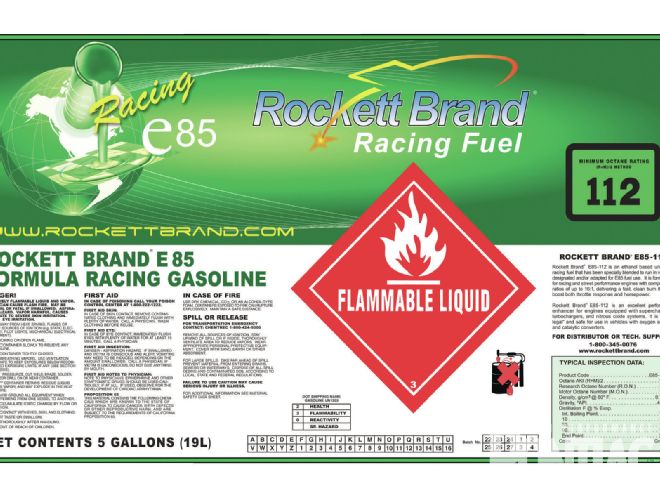 Rockett also produces E85 race fuel.
Rockett also produces E85 race fuel.
Gasoline is considered to be fungible, a term which describes something that is so similar in composition that it can be mixed together with no adverse effect. This happens everyday when you buy a tank of fuel in one location and then refuel in another with a different brand or grade. Have you ever noticed that your daily driver may run better on a certain tank of fuel? Weather conditions affect how any engine performs, but keeping the conditions constant, the variation in the way the fuel is produced, can alter the power of the engine. For this reason if you compete with your Pontiac, it is best to tune it to one brand of race fuel and always use that blend.
For example, Rockett race gas is made to very tight quality standards, so the normal fluctuation that is seen with pump gas is eliminated. The most consistent engine performance is realized when the engine is calibrated for a certain fuel composition and it is not altered. Though the oil companies try to do this with street gas, they cannot adhere to the same consistency level that a company such as Rockett can. It would make the price at the pump too high and the consumer would reject the product. You can think of pump gasoline as a quality mineral engine oil but race gas as a highly refined synthetic engine oil such as Mobil 1 or AMSOIL, with the price premium to match.
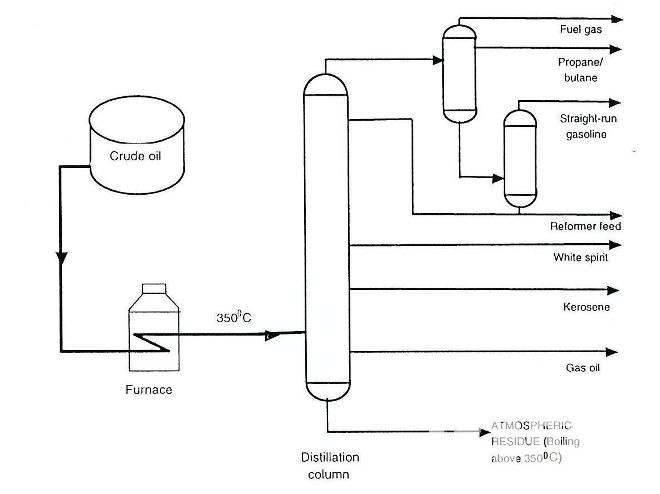 Crude oil is processed in a refinery and made into many different products with race gas being one of them. Most refineries are designed to work with a certain crude oil, such as West Texas Intermediate.
Crude oil is processed in a refinery and made into many different products with race gas being one of them. Most refineries are designed to work with a certain crude oil, such as West Texas Intermediate.
The chemistry of gasoline is quite complex and does not need to be fully grasped to become an educated consumer, but there are some key points that should be understood. These are the areas that we will discuss in this primer. If more in-depth knowledge is desired, HPP suggests you visit the website for Rockett Brand Racing Fuel and read the many informative technical bulletins.
Though the following discussion will be focused on race gasoline, all of the theory can be transferred to pump gas.
Gasoline purchases are usually made based upon octane. Even though octane is important, it is far from the only consideration and is often misunderstood. What should drive your decision is the energy content, burn rate, specific gravity, with or without oxygenate, and octane.
Fuel’s ability to resist detonation from pressure and/or heat is its octane rating—the higher the number the more resistant the gas is to auto-ignition. The octane of the fuel forces it to wait for the arcing of the spark plug for ignition to occur and has no impact on the ability to make power or offer improved fuel economy as long as the engine is not detonating. The minimum octane the engine requires to hold off abnormal combustion (ping or detonation) is all that is necessary. If the engine runs better with a higher-octane fuel, it is experiencing abnormal combustion with the lower octane fuel even though you may not hear it. The only other factor could be that the composition of the higher octane fuel is different from the lower grade.
The method to determine the octane of modern pump gas is often identified as the AKI, or ant-knock index. It is the average of two different tests: research octane number (RON) and the motor octane number (MON). RON is determined in a single cylinder variable compression ratio engine that operates at 600 rpm with a 125 degrees F inlet temperature and at standard barometric pressure. The RON is an indicator of the fuel’s ability to resist detonation at part throttle. MON value is determined in a single cylinder engine as well, but runs at 900 rpm with a 300 degree F incoming air temperature. The MON is a better indicator of the fuel’s performance under wide-open-throttle.
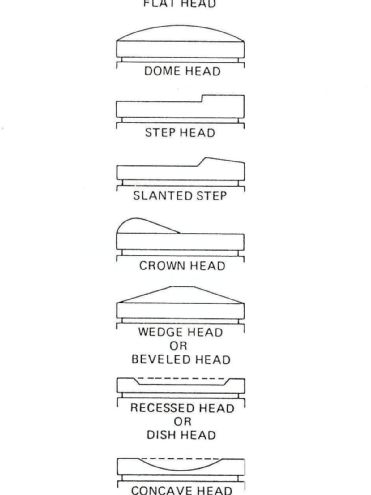 The octane tolerance of the engine is a direct function of its design. A domed piston will offer an obstacle to the flame travel and require more ignition lead, and, in turn, possibly a higher octane fuel.
The octane tolerance of the engine is a direct function of its design. A domed piston will offer an obstacle to the flame travel and require more ignition lead, and, in turn, possibly a higher octane fuel.
Since modern gasoline’s octane is calculated as RON + MON/ 2 = AKI, its octane is much higher than many assume when compared to the ’60s when this standard was not employed. It is important to note that when purchasing a race gas, it must be known how the octane was measured. Rockett Brand uses the AKI method of averaging the RON and MON, which is the most accurate and most widely understood.
Many design factors impact the octane requirement of the engine, such as the compression ratio, combustion-chamber design, cylinder-head material, tuning, and temperature of the coolant and air along with the altitude. A common mistake is to think that a higher octane fuel has more power—it does not.
This now comes to an area that is rarely discussed—the energy content of the fuel. Energy is measured in Btu for British thermal units. A gallon of gasoline contains between 115,000 and 125,000 Btu. It is the job of the engine through its design and tuning to realize as much of that energy potential as possible. A blend of gas that has more Btu will produce more horsepower, crisper performance, and improved fuel mileage over a lower energy-content fuel. When you buy gasoline, the energy content is not advertised. In your daily driver the fuel mileage is a good indicator of the Btu, if you compare like driving conditions and weather. Remember, an engine converts chemical to mechanical energy. The more energy the fuel has, the more potential for power exists.
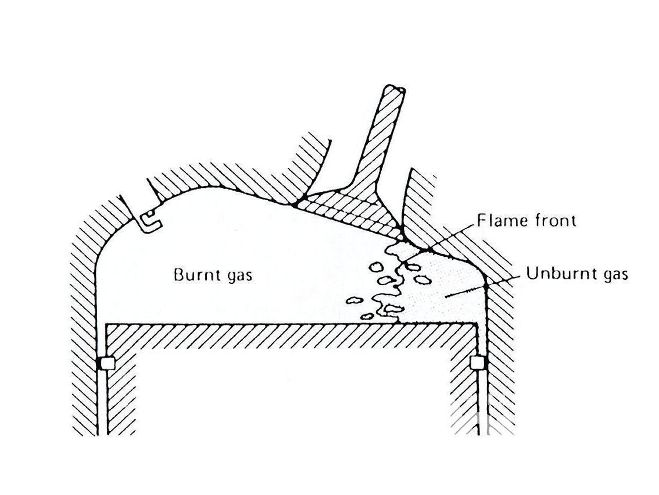 The burn rate of the fuel is critical as engine operating speed increases. If the fuel burns too slowly, it will not transfer power to the crankshaft. It will be burning in the exhaust port and header primary tube.
The burn rate of the fuel is critical as engine operating speed increases. If the fuel burns too slowly, it will not transfer power to the crankshaft. It will be burning in the exhaust port and header primary tube.
When this logic is applied to race gasoline, a caveat needs to be attached—the burn rate of the fuel. Pump gasoline is formulated for an engine that will run between 2,000 to 3,000 rpm the majority of the time. The quicker the fuel burns, the more potential energy release there is before the exhaust valve opens. As engine speed increases, the burn rate of the fuel becomes essential to produce power.
For example, if the engine was supplied with a fuel that burns well up to 5,000 rpm but peak horsepower is produced at 7,000 rpm, the exhaust valve would already be opened and the energy would go out the tailpipe instead of working against the piston. This will produce artificially high exhaust-gas temperature and waste the energy in the fuel. Thus, a major design component of Rockett race gasoline, even the street 100-octane unleaded, is a quick burn rate. A fast burn rate will never cost you power, but a slow burn has the potential to diminish performance.
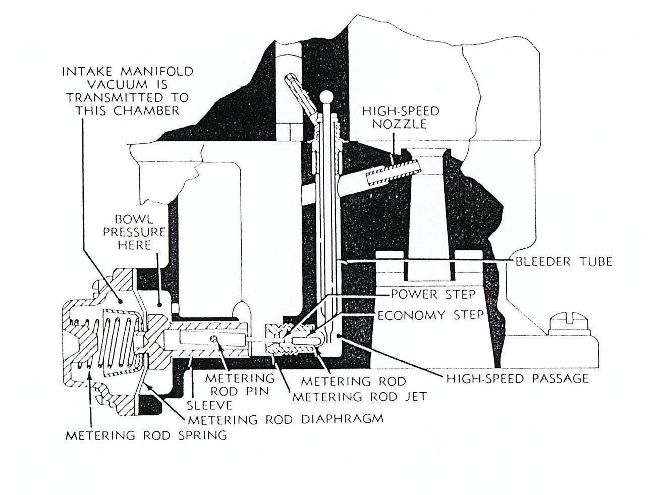 The specific gravity of the fuel will impact how it is carried through the passages of the carburetor. It can be tuned with air-bleed size and emulsion holes.
The specific gravity of the fuel will impact how it is carried through the passages of the carburetor. It can be tuned with air-bleed size and emulsion holes.
When it comes to race fuel, the energy content and the burn rate need to be recognized and cannot be referenced independently of one another. The burn rate is a result of the chemical composition of the race gasoline and not all race fuels are fast burn. It cannot be assumed that because it is a race gas it is fast burn. This brings us back to tuning the engine for the fuel used. All Rockett fuel is designed with a fast-burn characteristic—and 118 is the fastest.
The physical weight of the fuel is determined by its specific gravity. It is read as a decimal such as 0.743 and is temperature corrected to a standard (60 degrees F). Weight is not a determination of its energy content, since the mass of the components that are used to blend the fuel will impact the specific gravity. Modern street gasoline that is mixed with 10 percent ethanol weighs more, since alcohol is heavier than straight gasoline.
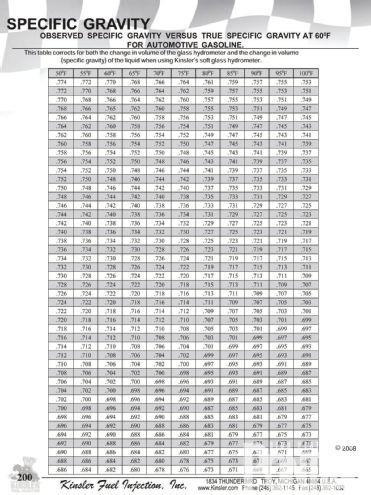 The standard temperature for specific gravity is 60 degrees F. This chart from Kinsler shows how to correct that value for a change in fuel temperature.
The standard temperature for specific gravity is 60 degrees F. This chart from Kinsler shows how to correct that value for a change in fuel temperature.
Because the carburetor needs to be calibrated for it, the specific gravity of the fuel is important. A carburetor functions on a pressure differential that responds to the amount of depression in the cylinder bore (low pressure) in relation to the atmospheric pressure. As the throttle plate is opened and passages are exposed, the fuel needs to be lifted from the float bowl and sent through the circuits. In most carburetors and especially those that are patterned from a Holley design, the air bleeds and those located in the emulsion passage in the metering block are critical to this. Thus if the specific gravity of a fuel is altered, then the air bleed and emulsion hole(s) size and/or position may need to be modified to compensate for the change in weight. That is why race gasoline specifications supply the specific gravity of the blend. Street gasoline is so close in specific gravity that your car runs fine with different blends and brands. But when it comes to racing, everything needs to work in harmony for the best power.
Just as it is with race gasoline, street gas is a product of its components. What usually makes a pump gasoline brand specific is the additive package that is blended into it. The raw gasoline is considered a base fuel and is usually sourced from only a few different refineries in an area. At the distribution center, the base fuel is then mixed with the brand-specific additive package as it is being filled in the tanker truck for delivery. That is what makes the difference in the brands of pump gas.
The federal and many local governments have guidelines for fuel and these are called boutique blends. Also, the EPA has a minimum amount of additives that must be mixed in to deter fuel injector and intake-valve deposit formation. Some brands of fuel (usually the name brands) may add more of this, while also including a detergent that helps to remove deposits already formed. Carbon deposits are the bane of every engine, affecting drivability, power, idle quality, and emissions along with fuel economy.
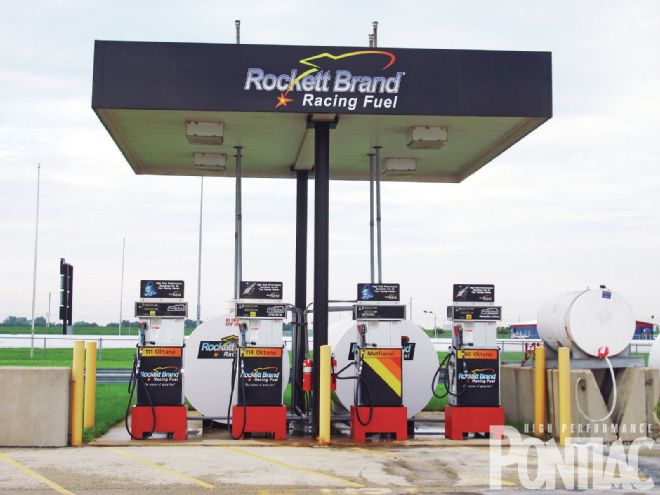 Rockett Brand Racing Fuel offers a variety of products for different needs. Many tracks offer pumps and a broad selection.
Rockett Brand Racing Fuel offers a variety of products for different needs. Many tracks offer pumps and a broad selection.
Modern pump gasoline is considered RFG for reformulated gasoline. This is in response to federal clean air laws that require more efficient combustion for a reduction in tailpipe emissions. In most parts of the country, RFG contains a mix of 10-percent ethanol as an oxygenate. Contrary to what many believe, RFG with ethanol is an excellent product and in many ways is superior to what we used in the glory days of the ’60s and ’70s. Even in the strictest environmental state, California, today’s gas is an excellent fuel and better than we realize. The problem being an older engine especially with a carburetor and distributor, is not calibrated to work with the modern fuel. The good thing is a knowledgeable tune-up man will have no problem making the necessary adjustments—a hint of what we discovered with our SD-455 fuel test. Tuning refers to complete carburetor and spark advance curve calibration, not just playing with the idle mixture screws and twisting the distributor a few degrees either way.
It is true that RFG, when enhanced with ethanol, has a slightly lower energy content, but repeated tests have proven the amount of impact it has on fuel mileage is so small that it is within the margin of error most see when figuring gas mileage.
Prior to the use of ethanol as an oxygenate for cleaner burning, a chemical called MTBE was employed. MTBE was an excellent product to mix with gasoline, since it stayed in solution and did not wick in moisture like alcohol, but it received a bad reputation as a ground water pollutant in some parts of the country. There is no denying that MTBE is a pollutant, but so is almost any other chemical. Legislation that some have argued was more media-driven than fact-based resulted in outlawing MTBE, which later lead to ethanol use. Opponents of corn-based ethanol production should blame politicians, not farmers.
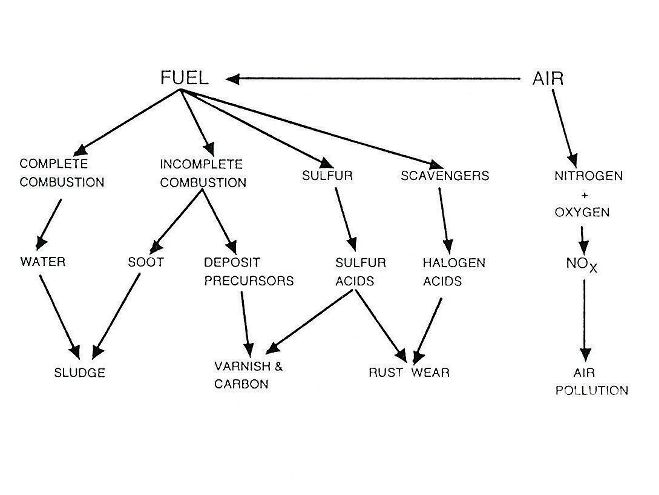 Race engines have specific needs for the best energy conversion from the fuel. As you can see here, street gasoline is concerned with other factors.
Race engines have specific needs for the best energy conversion from the fuel. As you can see here, street gasoline is concerned with other factors.
Making Sense of It All
When it comes to fueling an older Pontiac with modern gasoline, the engine will perform great but it most likely will require one-time tuning from a knowledgeable person. If your Pontiac is used in competition, then a proper race gas, such as that from Rockett, should be employed. To pick the proper fuel, call the Rockett technical line for the best recommendation; then tune the engine to the Rockett fuel and you are done. The only thing left will be to go to the track and blow past the competition.
Your Pontiac will truly be converting chemical into mechanical energy. Isn’t that what it’s all about?